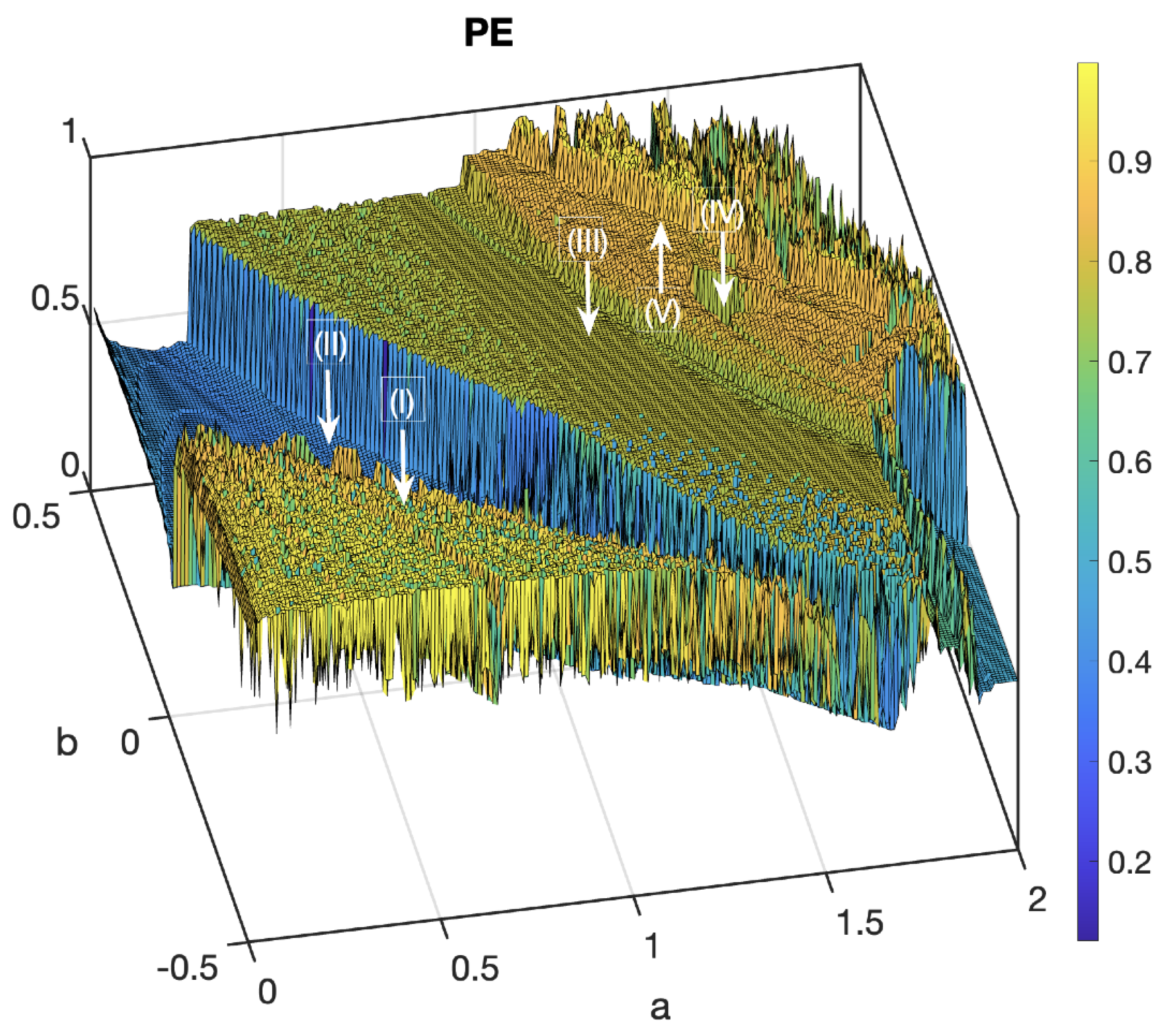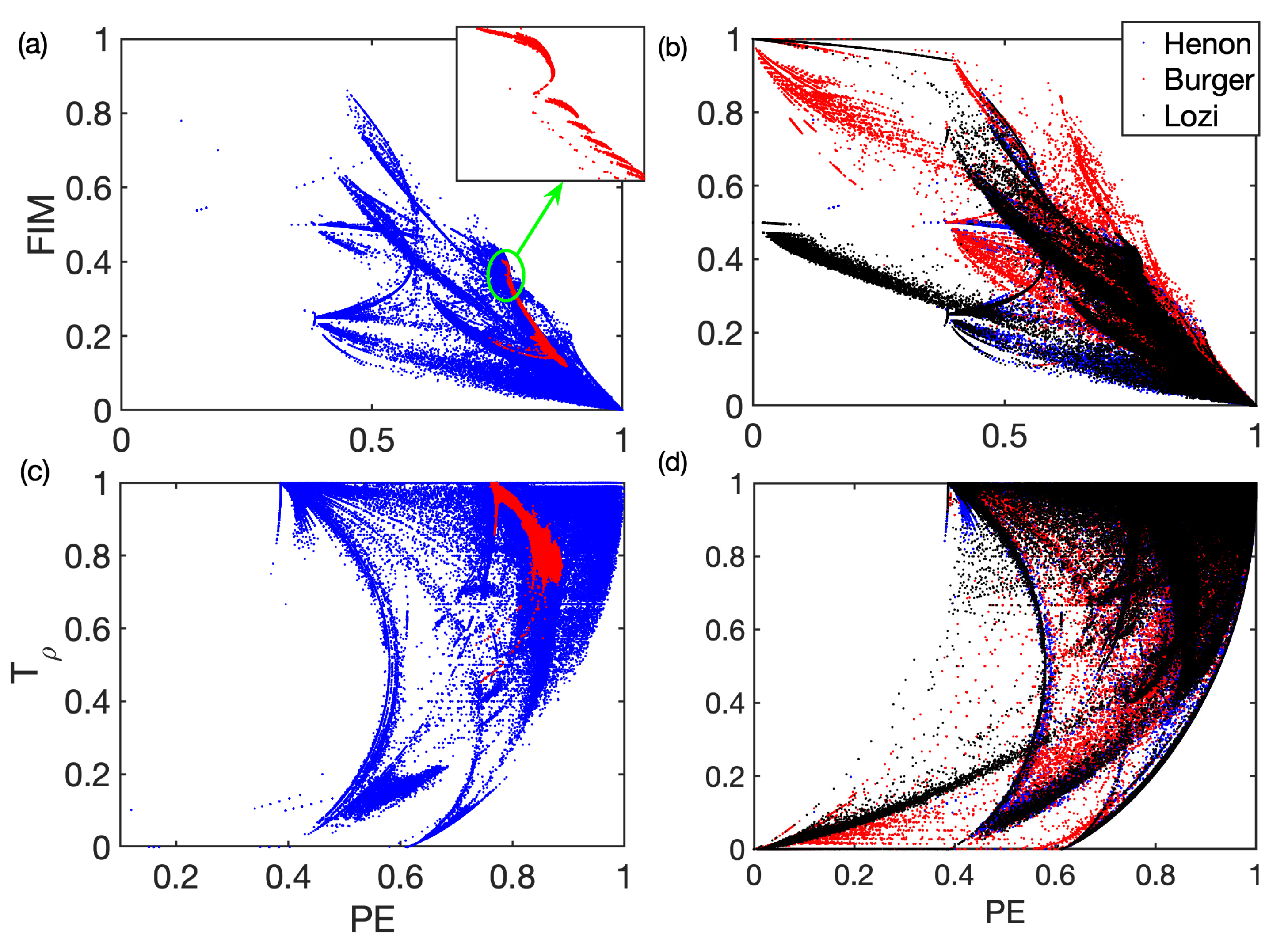Unveiling Dynamical Symmetries in 2D Chaotic Iterative Maps with Ordinal-Patterns-Based Complexity Quantifiers
Abstract
:1. Introduction
2. Ordinal Patterns and Complexity Quantifiers
2.1. Ordinal Patterns (OPs)
2.2. Permutation Entropy (PE)
2.3. Fisher Information Measure (FIM)
2.4. Temporal and Reversible DYnamical Symmetries (TARDYS)
3. Hénon Map
3.1. 1D Analysis: ,
3.2. Two-Parameters Analysis
3.3. Initial Conditions Analysis
4. The Standard Map
5. Conclusions
Author Contributions
Funding
Data Availability Statement
Conflicts of Interest
Appendix A

References
- Tsonis, A.A.; Elsner, J.P. Nonlinear prediction as a way of distinguishing chaos from random fractal sequences. Nature 1992, 358, 217–220. [Google Scholar]
- Rosso, O.A.; Larrondo, H.A.; Martin, M.T.; Plastino, A.; Fuentes, M.A. Distinguishing Noise from Chaos. Phys. Rev. Lett. 2007, 99, 154102. [Google Scholar]
- Amil, P.; Soriano, M.C.; Masoller, C. Machine learning algorithms for predicting the amplitude of chaotic laser pulses. Chaos 2019, 29, 113111. [Google Scholar]
- Bianconi, G.; Arenas, A.; Biamonte, J.; Carr, L.D.; Kahng, B.; Kertesz, J.; Kurths, J.; Lu, L.; Masoller, C.; Motter, A.E.; et al. Complex systems in the spotlight: Next steps after the 2021 Nobel Prize in Physics. J. Phys. Complex 2023, 4, 010201. [Google Scholar]
- Bandt, C.; Pompe, B. Permutation Entropy: A Natural Complexity Measure for Time Series. Phys. Rev. Lett. 2002, 88, 174102. [Google Scholar]
- Zanin, M.; Olivares, F. Ordinal patterns-based methodologies for distinguishing chaos from noise in discrete time series. Comm. Phys. 2021, 4, 1038. [Google Scholar]
- Leyva, I.; Martínez, J.H.; Masoller, C.; Rosso, O.A.; Zanin, M. 20 years of ordinal patterns: Perspectives and challenges. Eur. Phys. Lett. 2022, 138, 31001. [Google Scholar]
- Vignat, C.; Bercher, J.F. Analysis of signals in the Fisher–Shannon information plane. Phys. Lett. A 2003, 312, 27–33. [Google Scholar]
- Parlitz, U.; Berg, S.; Luther, S.; Schirdewan, A.; Kurths, J.; Wessel, N. Classifying cardiac biosignals using ordinal pattern statistics and symbolic dynamics. Comp. Biol. Med. 2012, 42, 319–327. [Google Scholar]
- Ravetti, M.G.; Carpi, L.C.; Goncalves, B.A.; Frery, A.C.; Rosso, O.A. Distinguishing Noise from Chaos: Objective versus Subjective Criteria Using Horizontal Visibility Graph. Comp. Biol. Med. 2014, 9, 108004. [Google Scholar]
- Olivares, F.; Plastino, A.; Rosso, O.A. Contrasting chaos with noise via local versus global information quantifiers. Phys. Lett. A 2012, 376, 1577–1583. [Google Scholar]
- Spichak, D.; Kupetsky, A.; Aragoneses, A. Characterizing complexity of non-invertible chaotic maps in the Shannon–Fisher information plane with ordinal patterns. Chaos Sol. Fract. 2021, 142, 110492. [Google Scholar]
- Spichak, D.; Aragoneses, A. Exploiting the impact of ordering patterns in the Fisher-Shannon complexity plane. Chaos Sol. Fract. 2022, 154, 111620. [Google Scholar]
- Nguyen, N.; Pattanayak, A.K.; Aragoneses, A. TARDYS Quantifiers: Extracting Temporal and Reversible DYnamical Symmetries. Photonics 2022, 9, 938. [Google Scholar]
- Bandt, C. Small Order Patterns in Big Time Series: A Practical Guide. Entropy 2019, 21, 613. [Google Scholar]
- Hénon, M. A two-dimensional mapping with a strange attractor. Comm. Math. Phys. 1976, 50, 69. [Google Scholar]
- Yao, W.; Yao, W.; Wang, J.; Dai, J. Quantifying time irreversibility using probabilistic differences between symmetric permutations. Phys. Lett. A 2019, 383, 738. [Google Scholar]
- Olivares, F.; Zanin, M.; Zunino, L.; Pérez, D.G. Contrasting chaotic with stochastic dynamics via ordinal transition networks. Chaos 2020, 30, 063101. [Google Scholar]
- Silva, A.S.A.; Menezes, R.S.C.; Rosso, O.A.; Stosic, B.; Stosic, T. Complexity entropy-analysis of monthly rainfall time series in northeastern Brazil. Chaos Sol. Fract. 2021, 143, 110623. [Google Scholar]
- Zhang, C.; Li, Y. Koopman Operator and Phase Space Partition of Chaotic Map. Chaos 2020, 32, 063132. [Google Scholar]
- Fadlallah, B.; Chen, B.; Keil, A.; Príncipe, J. Weighted-permutation entropy: A complexity measure for time series incorporating amplitude information. Phys. Rev. E 2013, 87, 022911. [Google Scholar]
- Zhao, X.; Shang, P.; Huang, J. Permutation complexity and dependence measures of time series. Europ. Phys. Lett. 2013, 102, 40005. [Google Scholar]
- Zunino, L.; Olivares, F.; Rosso, O.A. Permutation min-entropy: An improved quantifier for unveiling subtle temporal correlations. Europ. Phys. Lett. 2015, 109, 10005. [Google Scholar]








| Pattern | Word |
|---|---|
| ‘123’ | 1 |
| ‘132’ | 2 |
| ‘213’ | 3 |
| ‘231’ | 4 |
| ‘312’ | 5 |
| ‘321’ | 6 |
Disclaimer/Publisher’s Note: The statements, opinions and data contained in all publications are solely those of the individual author(s) and contributor(s) and not of MDPI and/or the editor(s). MDPI and/or the editor(s) disclaim responsibility for any injury to people or property resulting from any ideas, methods, instructions or products referred to in the content. |
© 2023 by the authors. Licensee MDPI, Basel, Switzerland. This article is an open access article distributed under the terms and conditions of the Creative Commons Attribution (CC BY) license (https://creativecommons.org/licenses/by/4.0/).
Share and Cite
Novak, B.S.; Aragoneses, A. Unveiling Dynamical Symmetries in 2D Chaotic Iterative Maps with Ordinal-Patterns-Based Complexity Quantifiers. Dynamics 2023, 3, 750-763. https://doi.org/10.3390/dynamics3040040
Novak BS, Aragoneses A. Unveiling Dynamical Symmetries in 2D Chaotic Iterative Maps with Ordinal-Patterns-Based Complexity Quantifiers. Dynamics. 2023; 3(4):750-763. https://doi.org/10.3390/dynamics3040040
Chicago/Turabian StyleNovak, Benjamin S., and Andrés Aragoneses. 2023. "Unveiling Dynamical Symmetries in 2D Chaotic Iterative Maps with Ordinal-Patterns-Based Complexity Quantifiers" Dynamics 3, no. 4: 750-763. https://doi.org/10.3390/dynamics3040040
APA StyleNovak, B. S., & Aragoneses, A. (2023). Unveiling Dynamical Symmetries in 2D Chaotic Iterative Maps with Ordinal-Patterns-Based Complexity Quantifiers. Dynamics, 3(4), 750-763. https://doi.org/10.3390/dynamics3040040









